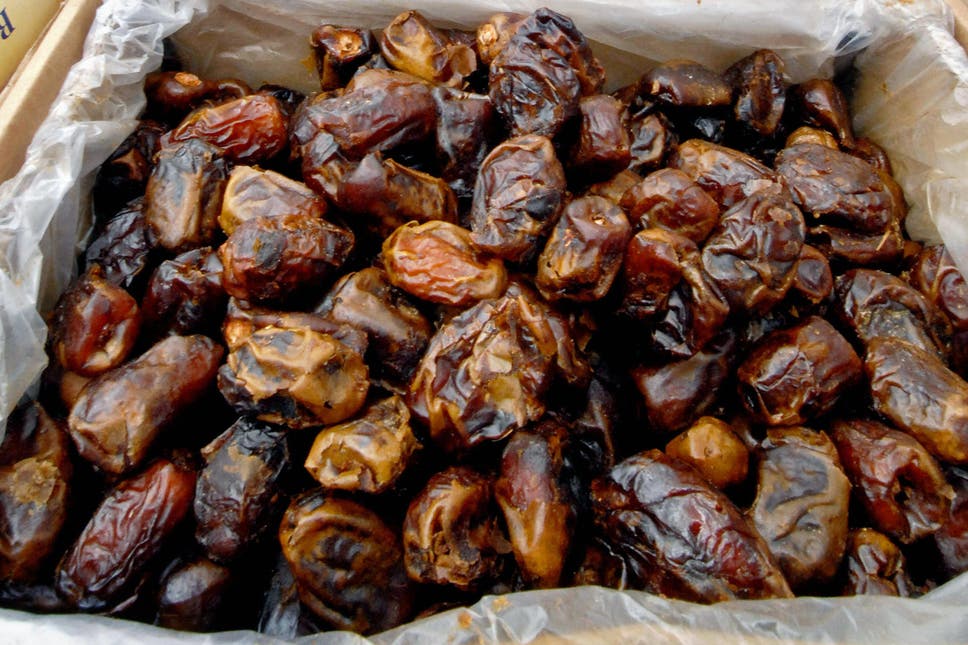
These dried ‘kurma’ are ready for shipment. The date is a very versatile fruit – you can have it fresh, dried, cooked or uncooked. — AFP photo
I AM sure many Malaysians like eating ‘kurma’ (dates), which would come in abundance during the Ramadan month.
In that sense, many also wonder if kurma palms could be planted here. Looking over the cover of the May 2021 issue of the ‘Info Pertanian’ magazine, it repeatedly reminds me to search for the truth about growing the kurma palms in Malaysia.

Former assemblyman Zulkifli Ali shows the ‘Ajwa’ date bunches from one of 10 date palms that he planted four years ago in the courtyard of his house in Selising, Kelantan. — Bernama photo
Mr Lim has informed me that there are planters in the east coast of Peninsular Malaysia who are engaged in planting this crop so as to cater to the local demand, especially during the fasting month.
Is Malaysia now trying to make it a real investment? The country’s annual import amounts to no less than RM250 million.
Dates are regarded as the world’s oldest cultivated fruit, and humans have been growing them for at least 6,000 years. Among the key growing countries are Australia, India, Pakistan, Egypt, Mexico, the US and a few countries in South America.
It is said that the date palm (Phoenix dactylifera) was first cultivated in the Middle East, specifically Mesopotamia where Iraq now sits on. Now, it can be found in some unexpected places like the Canary Islands. According to my one-time training mate in the US, Abdallah from Iraq, dates were so abundant during the harvesting season and they were very cheap indeed. However, the time was 1988.
Dates are a member of the palm family called the ‘Arecaceae’ (Palmae). The species name ‘dactylifera’ originates from two Greek words – ‘daktulos’ (finger) and ‘fero’ (‘I bear’). There are over 200 varieties of dates available worldwide.
In religious history, it was regarded as one of the seven holy fruits for the Jews.
Up till today, Muslims are advocated to break their day-long fast during the holy month of Ramadan by eating a few ‘kurma’ first before any other food.
The palm is a dioecious (having the male and female reproductive organs in separate individuals) – pollination is achieved by the female inflorescence, or by wind blowing across the flowers.
Bunches of maturing fruit may be protected from rain damage by covering them with paper sleeves. Each palm could yield up to 12 bunches, which in turn, produce 10kg of dried fruit dates.
The fruits that we buy from the markets are each a drupe, measuring about 4cm in length and 2cm in diameter, and containing a single seed with a groove along one side.
After harvest, fruits are cured by heating and removing the tannins and astringent. Under favourable weather conditions, the fruit would ripen naturally on the palms and could be eaten fresh.
Cultivation techniques
Date palms require tropical heat climate, with lesser rainfall. It can withstand drought and land with high salinity – provided that it is well-drained. It would be ideal to have dry season for fruiting time. Soil fertility is not critical either. Irrigation is called for during fruiting and to ensure good growth.
Date seedlings are variable and take many years to come into cropping, and the female trees can only be identified after flowering.
It is more desirable to use selected clones and take suckers from the mother palms, although it is a tough job to handle the spikes on the suckers. Propagation is slow, tedious and expensive; therefore, using tissue culture could solve the planting needs.

Photo shows date palm trees at a farm in the southern Iraqi city of Basra. — AFP photo
Good cultivars like ‘Deglet Noor’ or ‘Kurma Chaeta’ (Sunlight Dates) are used in Algeria and also in California, the US. Cultivar Medjool, originating from Morocco, produces bigger fruits wanted by the global markets.
Other cultivars like Barnee and Halaway (sweet variety) produce better quality fruits that have originated from Iraq.
Today, we have yet to try this date palm planting here, but I might be wrong as our exchange of materials can pass through without our knowledge.
Versatile fruit
The date is a very versatile fruit – you can have it fresh, dried, cooked or uncooked.

The ‘kurma’ (dates) would always come in abundance during the Ramadan month. — Bernama photo
The ‘cull dates’ (fruits that are too hard, too small, blemished, of poor appearance, infested or containing foreign matter) are used for production of stock feed.
Dates are said to have good antioxidant, anti-microbial and anti-inflammatory properties.
The fruit is rich in carbohydrates, accounting for 75 per cent of total nutritional value, mostly consisting of fructose and glucose in equal ratio.
The minerals mainly present are calcium, iron, magnesium, selenium, copper, phosphorus, potassium and zinc.
It is a staple food for those living in the desert regions across the Middle East.
As for many of us, we already regard it as a sweet and delicious after-meal treat.
Happy gardening!
